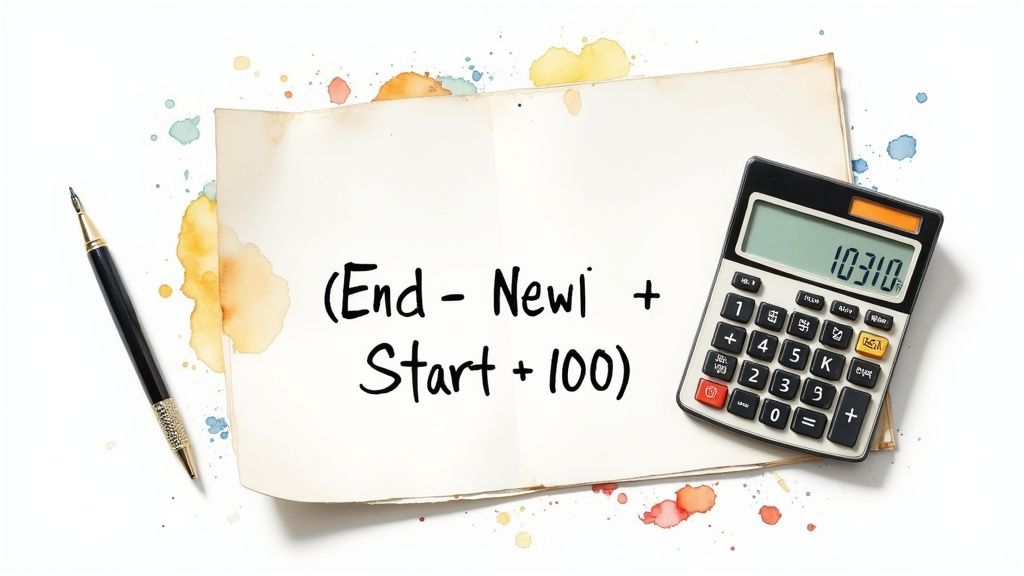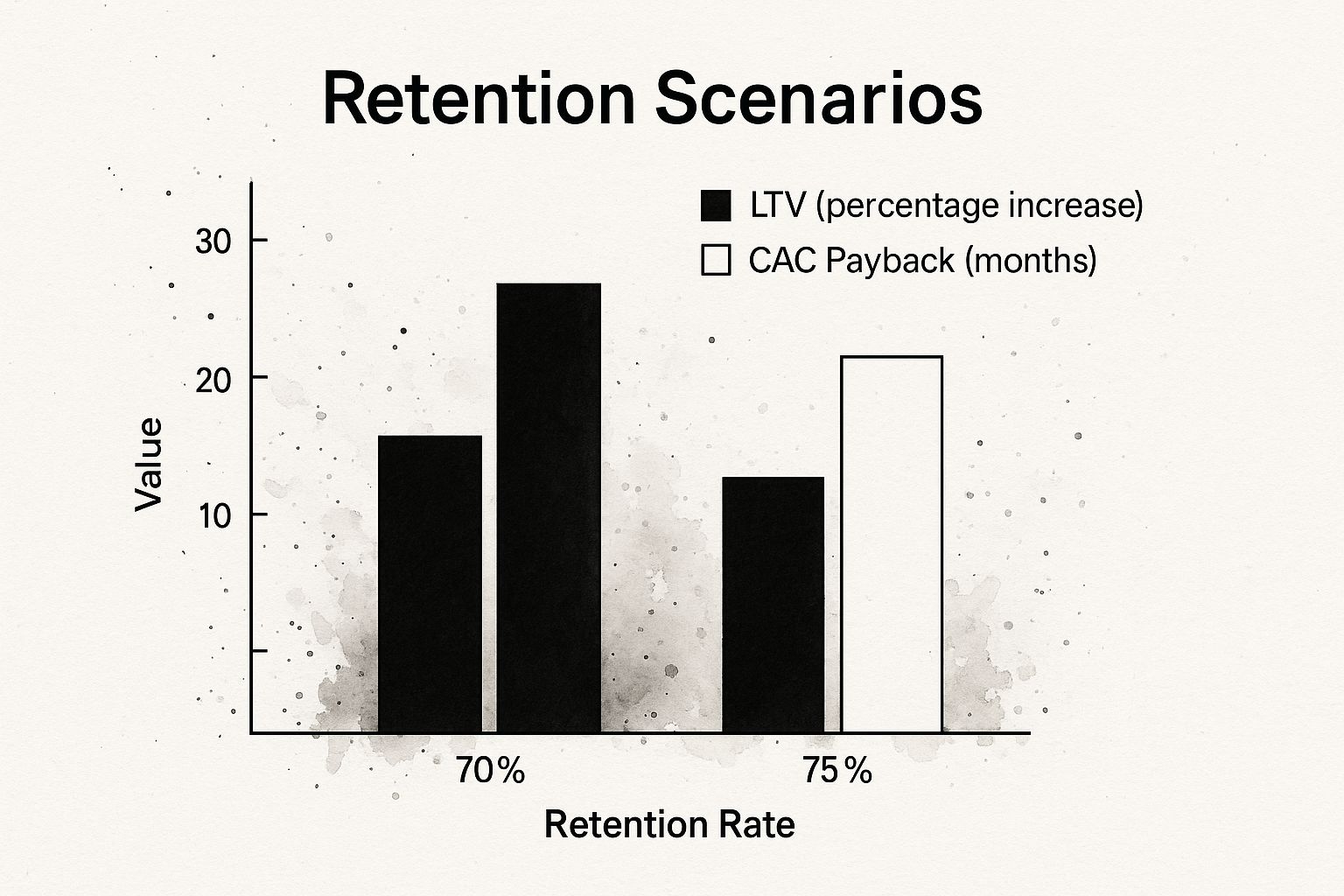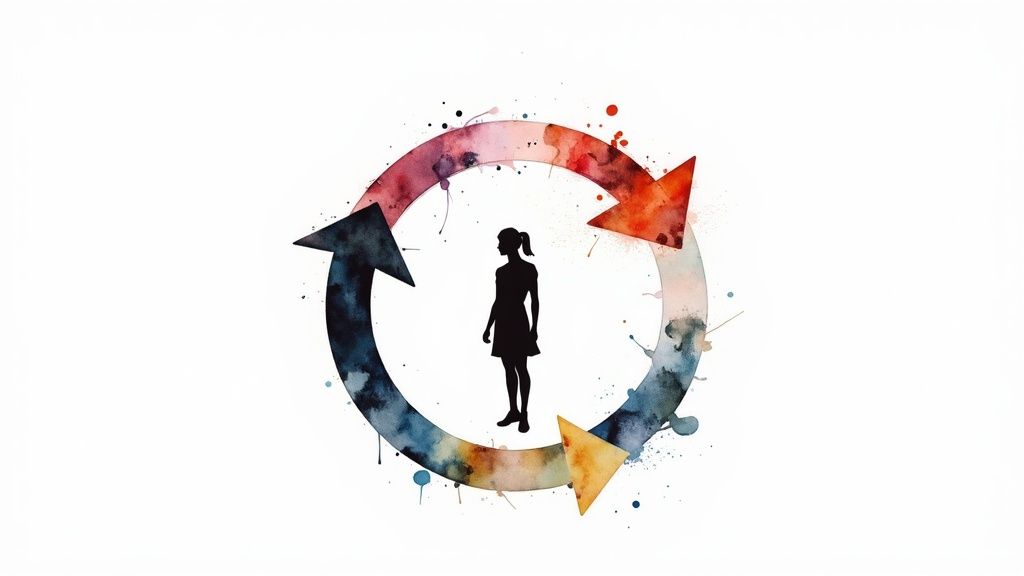Your Growth Is A Lie. Here's The Math That Proves It.
Stop bleeding users. Learn how to calculate, benchmark, and actually improve your customer retention rate with no-BS strategies that prevent churn.
Posted by
Related reading
Customer Retention Metrics: The No-BS Guide for Founders
Stop guessing. Learn the essential customer retention metric formulas and strategies to turn your data into predictable, long-term business growth.
NPS Formula Calculator: Find Your Score in Seconds
Use our NPS formula calculator to get your Net Promoter Score instantly. Learn the formula, interpret your score, and avoid common calculation mistakes.
Stop Guessing Churn. Use This Simple Calculator to See How Much Money You’re Burning
Your churn isn’t a mystery. Use this simple churn cost calculator to see how much revenue you’re losing every month—and how better feedback analysis can win it back.
You think you're crushing it. New logos are rolling in, MRR is ticking up, and the vanity metrics on your dashboard look great.
Congratulations. You’ve mastered the art of pouring water into a leaky bucket.
While you’re busy celebrating your acquisition wins, the customers you already paid a fortune to get are quietly hitting the "cancel subscription" button. That's not growth. It’s an expensive, exhausting treadmill, and you’re one bad quarter away from flying off the back.
Your Growth Is Probably A Lie
Here’s the hard truth your VCs won't tell you: most startup "growth" is just a frantic sprint to replace what you're losing. Every new customer costs more than the last, while the ones you already bled for are ghosting you. That isn't a business; it's a glorified marketing experiment with a high burn rate.
Think of your company as a bucket. Marketing and sales work their asses off hauling water to fill it. But if the bucket has holes—a clunky onboarding, a confusing product, ghost-town support—it doesn’t matter how fast you pour. You're just making a bigger puddle.
That leakage is your customer churn. And the frantic pouring? That's your Customer Acquisition Cost (CAC) spiraling into the stratosphere.
The Real Cost Of Ignoring The Leak
Tempted to just pour faster? Raise another round, hire more salespeople, dump cash into ads? That’s a game you can’t win. As you burn through early adopters, your CAC will inevitably climb.
Soon, you're spending five to twenty-five times more to attract a new customer than it costs to keep an existing one. Read that again. You're paying a massive premium to replace people who had already decided you were worth their money.
Your customer retention rate isn't a KPI for a slide deck. It's the truest measure of your product's pulse. Ignore it, and you’ll be lucky to survive the quarter.
Ignoring retention is the classic, fatal mistake. It’s the difference between building a fortress of predictable revenue and a house of cards. This isn't about feel-good platitudes. This is about the cold, hard math of not sinking your own ship.
Takeaway: Stop celebrating new logos until you've stopped the bleeding from the ones you already have.
Calculate Your Retention Rate Without an MBA

You don't need a finance degree for this. Forget the complicated formulas and academic fluff. There's one customer retention rate formula that tells you if people actually value your product or if you're just renting users who will ditch you the second a competitor winks at them.
This is a diagnostic tool, not a homework assignment.
The Only Formula That Matters
All you need are three numbers for a given period. I use monthly. It’s the right cadence.
- Customers at the Start (S): How many paying customers on day one of the month?
- Customers at the End (E): How many on the last day?
- New Customers Acquired (N): How many new logos did you close?
Plug them into this. No excuses.
((E - N) / S) * 100 = Your Customer Retention Rate (CRR)
The (E - N) part is the gut check. It strips out the new blood so you can see who actually stuck around. For a step-by-step breakdown, check this resource on how to calculate retention rate.
Customer Retention Rate Calculation Example
Let's use a SaaS startup in April.
| Metric | Value | Description |
|---|---|---|
| Customers at Start (S) | 500 | Active subs on April 1st. |
| Customers at End (E) | 520 | Active subs on April 30th. |
| New Customers (N) | 45 | New customers acquired in April. |
| Calculation | ((520 - 45) / 500) * 100 | The math doesn't lie. |
| Retention Rate (CRR) | 95% | They kept 95% of their existing customers. Not bad. |
The math is simple. The truth it reveals is brutal.
Where The Lie Hides In Plain Sight
Now, let's look at "GrowthRocket," a fictional company that looks like it's killing it.
They start the month with 1,000 customers (S). Sales crushes quota and brings in 300 new customers (N). The dashboard shows 1,150 total customers (E).
The CEO is popping champagne. Net growth of 150 customers!
But let’s do the real math.
- E = 1,150
- N = 300
- S = 1,000
((1,150 - 300) / 1,000) * 100 = 85%
Their monthly customer retention rate is 85%. Their monthly churn rate is 15%. A 15% monthly churn is a five-alarm fire. Compounded, that’s a death spiral.
Their "growth" was just masking a catastrophic leak. They had to acquire 300 new customers just to net 150. This isn't growth; it's an expensive, exhausting treadmill. Retention is just one piece; learn about related metrics in this guide on how to measure customer loyalty.
Takeaway: Your top-line growth is a vanity metric until you prove your retention isn't garbage.
Why Retention Is the One Metric That Matters
You’re drowning in acronyms: CAC, LTV, MRR, ARR. Your dashboard looks like a bowl of alphabet soup. If your customer retention rate sucks, all of them are worthless.
A high retention rate is the foundation of a real business. A low one means you've built on quicksand.
Think of it this way: CAC is what you spend to get someone in the door. LTV is the profit you hope to make from them. Retention is the bridge between the two. If that bridge is rotten, your CAC is just cash you lit on fire and your LTV is a fantasy.
Retention Is the Engine of Profitability
Nailing retention isn't a small win; it's the whole game. When customers stick around, magic happens.
- Your CAC payback shrinks. You recoup acquisition costs faster, freeing up cash for real growth, not just replacing churn.
- Your LTV skyrockets. Loyal customers buy more. They upgrade, add seats, and try new features because they trust you.
- Your growth becomes predictable. You can finally forecast with confidence instead of chasing logos like a caffeine addict.
Bain & Company found that a 5% increase in retention can boost profits by 25% to 95%. This isn't marketing fluff. It's the compounding interest of not losing your customers. Discover more insights on how retention fuels profitability if you don't believe me.
Your business is not what you sell. It’s who you keep. A low retention rate is the market telling you your product is broken.
This chart shows how a tiny 5% bump in retention from 70% to 75% changes everything.

That small lift has a massive impact on LTV and how fast you get your money back.
The Hidden Army of Retained Customers
There’s another reason retention is your secret weapon. Happy, long-term customers become your volunteer marketing army. They leave glowing reviews, defend you online, and refer new customers who are already sold.
They also cost less to serve. They know your product, submit fewer support tickets, and are less sensitive to price increases.
Takeaway: Retention isn't a "nice to have"—it's the multiplier that makes every other part of your business work.
What a Good Customer Retention Rate Looks Like
Stop comparing your retention rate to Amazon's. You're not Amazon. Anyone who throws out a single "good" number is selling you snake oil.
Chasing a universal benchmark for your customer retention rate is a rookie mistake. It's like asking "What's a good speed?" without knowing if you're driving a school bus or a Formula 1 car. Context is everything. An 80% annual rate is a death sentence in enterprise SaaS but legendary in retail.
Your Industry Is Your Battleground
Know the terrain. Some industries are high-churn dogfights. Others are cozy fortresses.
Media and professional services often see retention around 84% because switching is a pain. In contrast, hospitality and travel average a brutal 55%. You can explore more industry-specific retention benchmarks to get a feel for your field.
The point isn't to feel good or bad. It's to get a realistic starting point.
A good retention rate isn't an absolute number. It's a relative advantage—over your direct competitors and, more importantly, over your past self.
Industry Benchmarks You Can Actually Use
Forget generic blog posts. Here's what survival looks like in different trenches.
| Industry | Average Retention Rate | What This Means For You |
|---|---|---|
| SaaS | ~80-95% (Annual) | Below 80% is a slow death. Elite B2B SaaS hits 95%+, a sign of an indispensable product. |
| E-commerce/Retail | ~63% (Annual) | This is a volume game where loyalty is fleeting. If you're beating this, your brand is a fortress. |
| Media/Publishing | ~84% (Annual) | Stickiness is high. Your biggest threat isn't churn; it's becoming irrelevant. |
| Fintech/Insurance | ~83% (Annual) | High switching costs are your friend. Customers are lazy until a competitor makes it painless to leave. |
These benchmarks just tell you the rules of the game you're playing.
Ditch the Averages and Set Your Own Target
Your most important competitor is the founder you were last month. The only number to obsess over is your own previous retention rate.
- Calculate Your Baseline: Pull your monthly retention for the last 12 months. No excuses.
- Analyze Your Cohorts: Are January signups churning faster than June's? Find out why. Your onboarding might be broken.
- Set an Improvement Goal: A 1-2% increase in monthly retention is a monumental win that compounds like crazy.
Stop looking at what everyone else is doing. A good customer retention rate is one that is consistently getting better.
Takeaway: The only retention benchmark that matters is beating your own past performance.
Strategies That Actually Stop Churn

Forget the "Ten Tips to Delight Your Customers" listicles written by interns. We aren't talking about sending birthday emails or loyalty programs for a branded koozie. That’s lipstick on a pig.
Real retention isn't about gimmicks. It’s about making your product so essential that leaving feels like a career-limiting move. This requires structural fixes, not marketing fluff.
Engineer an Indispensable First Thirty Seconds
The moment a user signs up is a high-stakes job interview. Your product is the candidate. If it can't prove its value instantly, you've lost.
Most onboarding is a self-indulgent product tour nobody cares about. A new user has one question: "Can this solve my painful problem right now?" Your UX better scream "YES."
A founder I know slashed day-one churn by 40% by replacing his generic welcome screen with a two-question setup wizard. It didn't ask for a name; it asked for the user's primary goal. The entire app then reconfigured itself around that single goal. It felt purpose-built.
Forget teaching users every feature. Your only onboarding goal is getting them to their first "Aha!" moment as brutally fast as possible.
Takeaway: Your onboarding isn't a tour. It's a surgical strike to prove value immediately.
Build a Feedback Loop That Isn’t a Graveyard
Most "feedback" systems are a joke. You send a stale SurveyMonkey form, get a few polite, useless responses, and file them in a digital graveyard. That's not listening; it's performing the act of listening.
The most valuable feedback comes from people who just fired you: your churned users.
Set up a simple, one-question survey that triggers the second someone clicks "cancel." The question? "What was the one thing we could have done differently to keep you?" Make it a required step in the cancellation flow.
A friend did this and found 30% of his churned users left because they didn't know a key feature existed. He was losing to his own bad UX. He built a win-back campaign targeting that specific feedback and recovered 15% of churned revenue in a month. For more, explore these proven strategies to reduce customer churn.
Takeaway: Treat your cancellation flow as your most valuable source of truth.
Master Surgical Personalization
Personalization isn't a {{first_name}} tag in an email. That’s amateur hour. True personalization is using data to anticipate a user's needs before they have them.
Track user behavior like a hawk. Which features do they use religiously? Where do they get stuck?
If a power user suddenly stops logging in, that’s a red flag. Don’t wait. Trigger an automated, personal-looking email from your own account: "Hey, noticed you haven't been in the app lately. Is everything okay? Did we break something?"
This isn’t creepy; it's proactive. It's how you stop churn before it starts. Find more detail in our guide on how to reduce customer churn.
Takeaway: Use data to solve problems before your customer ever has to tell you about them.
Time to Stop Guessing and Start Fixing
Alright, you know what customer retention rate is, how to calculate it, and why it's the metric that should keep you up at night.
This is where most founders bookmark the article for "later" and get back to chasing the dopamine hit of a new logo.
Don't be that founder.
Your business will sink or swim based on its ability to hold onto the customers you already fought to win. Every customer who stays is proof you’ve built something that matters. It’s time to stop treating retention as a "customer success" problem and see it for what it is: the absolute engine of your business.
The Real Work Begins Now
The strategies we talked about aren't a checklist. They demand a fundamental shift. Building a killer onboarding experience isn't a project; it's a constant process. Start by digging into these user onboarding best practices.
This is about building a fortress of predictable revenue, not just plugging a few leaks. Your survival depends on it. Now stop reading and go fix your leaky bucket.
Takeaway: Knowledge without action is just trivia. Go apply what you've learned.
End your churn guessing game by letting Backsy turn raw customer feedback into your single source of retention truth.
Still Have Questions About Retention?
Good. Skepticism means you're paying attention.
Retention Rate vs. Churn Rate: What’s the Difference?
They’re two sides of the same coin. Mathematical inverses. If your customer retention rate is 90%, your churn rate is 10%.
I focus on retention because it forces you to think offensively—building value to make people stay. "Reducing churn" feels defensive and reactive.
How Often Should I Calculate My Retention Rate?
Monthly.
Weekly is too noisy; you'll give yourself whiplash reacting to blips. Quarterly is flying blind while you bleed out. A monthly pulse gives you a clear, actionable trendline without making you paranoid.
The biggest mistake founders make with retention is ignoring it until it’s a crisis. By then, your best customers are gone and you’re in a death spiral.
Can a High Retention Rate Be a Trap?
Absolutely. You can have 100% retention and still fail spectacularly.
If you have ten customers and keep all ten, you have a perfect retention rate... and a hobby, not a business.
Retention is a vital sign, not a substitute for acquisition. You need both. A great customer retention rate just ensures your acquisition efforts aren't being poured into a leaky bucket. It makes your growth real.
Stop guessing what your customers want and start knowing. Backsy turns your messy, raw customer feedback into the exact roadmap you need to kill churn for good. Find out how at Backsy.ai